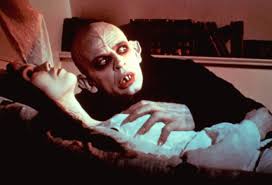
THE BLOODY JUDGE. (1970) DIRECTED AND CO-WRITTEN BY JESUS FRANCO.
PRODUCED BY HARRY ALAN TOWERS.
MUSIC BY BRUCE NICOLAI.
STARRING CHRISTOPHER LEE, LEO GENN, MARIA ROHM, MILO QUESADA AND HOWARD VERNON.
REVIEW BY SANDRA HARRIS. ©
I loved this robust seventeenth century romp, despite its being a tiny bit of a mess. It’s not really sure whether it’s a war film, a biopic of Judge Jeffries, an erotic nudie film, a film about a witch-finder or a film about the Inquisition.
Instead, it ends up being a mish-mash of all of these things, with the flavour of five different countries to boot, thanks to the tendency of the producer, Harry Alan Towers, to involve a load of different countries in the money-gathering stage of production, thus making this movie an Anglo-American-German-Spanish-French-Italian co-production. There’s a mouthful for you. It might explain, however, why the spoken dialogue in the film switched three times to angry-sounding German without warning…!
The magnificent Christopher Lee, renowned Hammer Horror actor most commonly identified with the role of Bram Stoker’s Dracula, is the main character here, the titular ‘Bloody Judge.’
He’s only about forty-eight here and looks ridiculously handsome and stern, playing that cold, austere disciplinarian and authority figure he’s portrayed so well and so often during his long and prolific career.
He’s based on the real-life Lord Chief Justice of the seventeenth century, during that period of English history when fear stalked that green and pleasant land and saying the wrong thing to the wrong person could have you up in front of a judge charged with nearly the worst crime of all, treason. Sounds kind of like another bad, more modern, period in history, doesn’t it?
In 1685, Judge Jeffries is sent by London to the West Country, to deal with the soldiers and civilians who aided, abetted and participated in Monmouth’s Rebellion against King James the Second. As always, the sadistic Jeffries (Christopher Lee) is only too happy to help.
He convicts huge numbers of men and women of treason and sentences them to death first by hanging, then they must be revived so they can be drawn and quartered, all the while feeling every modicum of pain. How fiendishly cruel and ghoulish!
The Judge, characterised by his unreasonableness, his total lack of empathy and compassion, his sense of humour bypass and devilish sexual urges, is also busy ‘smelling out witches,’ a dangerous thing indeed if you happen to be a young attractive local woman, with long, free-flowing hair, an ample bosom spilling out over the top of a flouncy, low-cut peasant blouse and a vocabulary designed to utter only two phrases in all:
Woman when being tortured: ‘Stop, please!’
Woman when being raped: ‘Oh, no, please, no!’
Yes, the women in the film are only there to be thoroughly ‘gone over’ for signs of witchcraft by Jack Ketch, the vile executioner, in his horrible underground torture chamber. Women are stripped and subjected to the whip, the rack, branding with a hot iron, the pliers- for extracting teeth- and wholly non-consensual sexual activities.
Ketch, a dead ringer for the sinister Boris Karloff in TOWER OF LONDON (1939), a film in which Basil Rathbone sports a most unflattering hairstyle, watches with his tongue hanging out as Mary Gray, the lead female and a prisoner, kneels naked and licks the bare, whipped body of another beautiful woman who’s suspended from a low ceiling and barely conscious.
In another scene, the Bloody Judge himself seduces-slash-ravages the frightened Mary Gray, who wants it really, as I’m sure you agree… We hear Christopher Lee’s deep, sexy infinitely cultivated voice murmuring sweet nothings over Mary’s naked body while a stunt hand fondles her nudieness, so it’s a bit of a swizz really, like the time I thought it was Chris’s bare behind I was seeing in the 1976 film, TO THE DEVIL A DAUGHTER, but it was only his stunt double’s…!
Leo Genn of QUO VADIS fame is excellent as the Earl of Wessex, father to Mary’s lover, Harry. There’s a great musical score by Bruno Nicolai, who in his lifetime worked with Ennio Morricone. The ending is quite fitting too, but I won’t spoil it for you, though naturally I’m dying to, haha.
There’s some gorgeous scenery of countryside in the film, known in the USA as NIGHT OF THE BLOOD MONSTER, though I don’t know why, as it doesn’t seem to make any sense to me. I’m not sure in which country the countryside footage was shot; I’m not even sure if it’s English or European.
The film has, of course, been compared to THE WITCHFINDER GENERAL (1968) and Michael Armstrong’s movie, MARK OF THE DEVIL (1970), but all three films have their merits, in my humble opinion, and I love all three of ‘em.Watch them all back-to-back if you can; make an evening of it! And if you like torture chambers and seeing innocent people in terrible agony at the whim of another, well, you’re in for a delicious treat…







